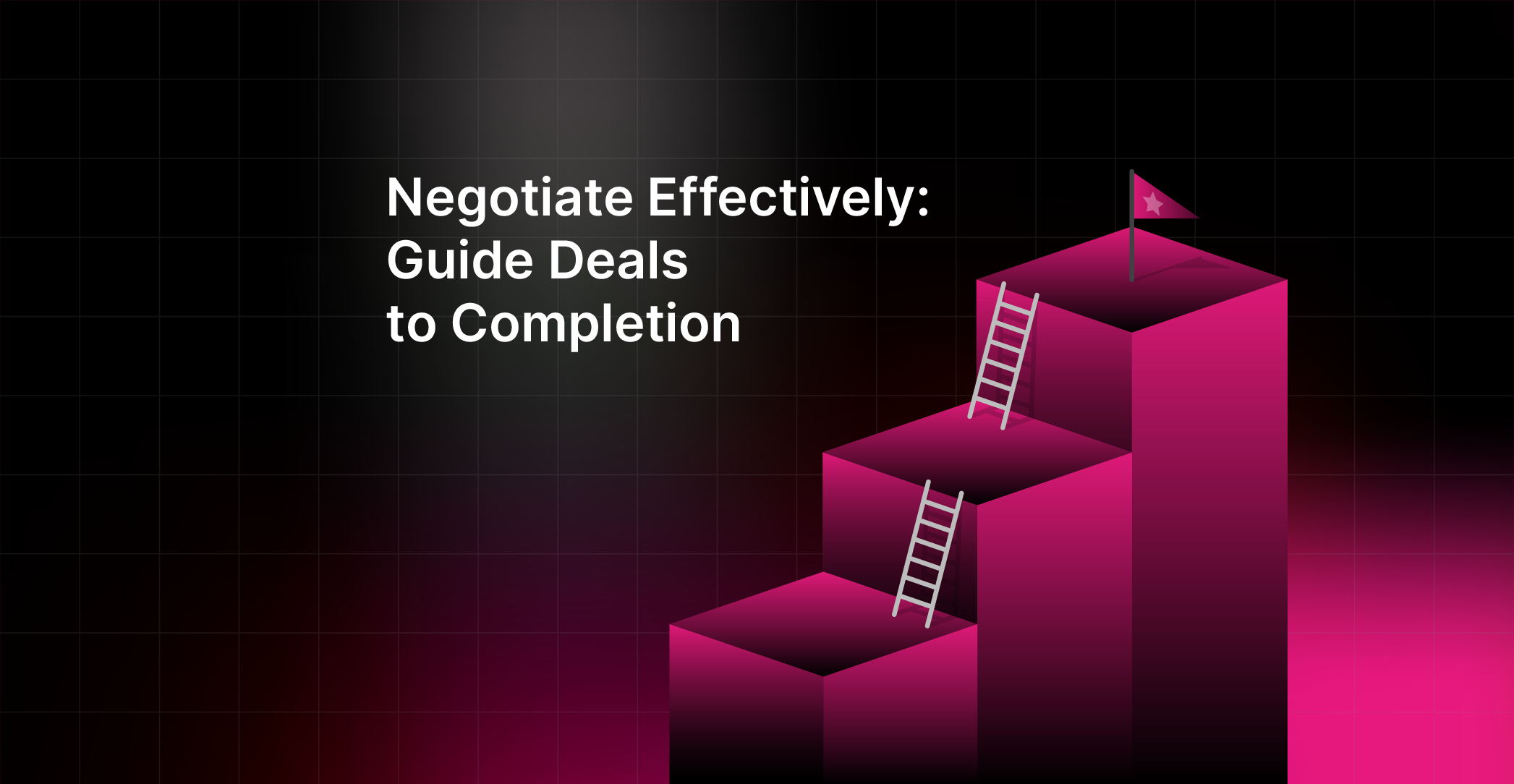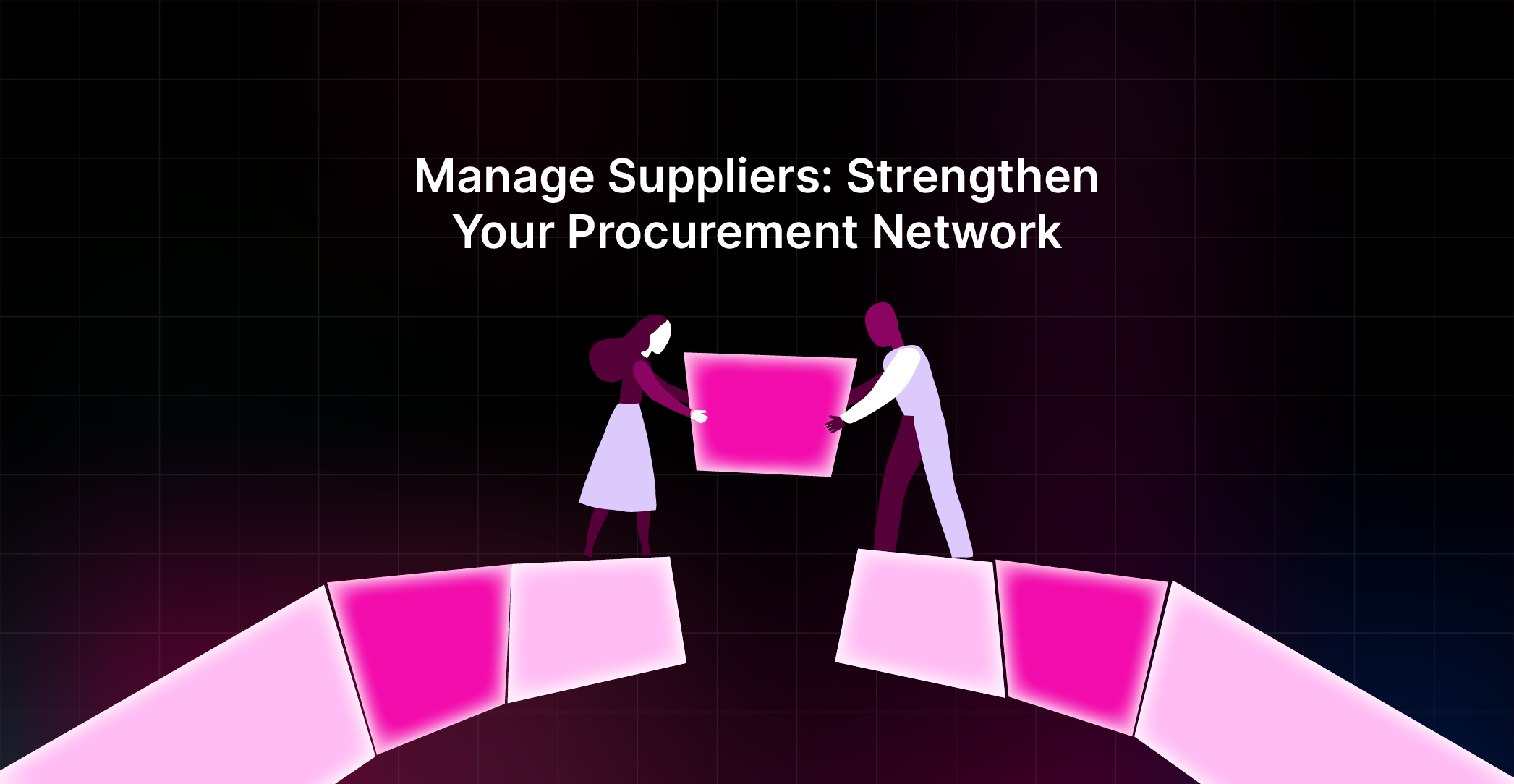

From Procurement Negotiation to Final Agreement: A Step-by-Step Guide

From Procurement Negotiation to Final Agreement: A Step-by-Step Guide
Dive deep into procurement negotiation strategies, from the basics of negotiated procurement to the intricacies of negotiating procurement agreements.


“Nearly one in three procurement projects fail to meet their objectives.” That’s not just a statistic, it’s a signal. Procurement is evolving fast, and the stakes are higher than ever.
As businesses balance tight budgets, vendor relationships, and compliance demands, an effective procurement plan can be the difference between savings and overspending. Let’s look at why structured planning matters and how it shapes successful outcomes.
What is Procurement Planning? Definition and Importance
Procurement planning is the process of identifying what goods or services an organization needs, when they are needed, and how they will be acquired. It defines purchasing methods, sets timelines and budgets, and assigns responsibilities to ensure every purchase supports business goals efficiently and cost-effectively.
Importance of Procurement Planning
Procurement planning plays a critical role in ensuring that an organization’s purchasing activities align with its strategic goals. A well-structured procurement plan helps businesses optimize costs, minimize risks, and improve efficiency. It also fosters compliance with procurement policies and enhances transparency across all stages of the purchasing process.
Here are some key reasons why procurement planning is essential:
1. Ensures Successful Project Execution
A structured procurement plan lays the foundation for smooth project execution. By identifying required resources, estimated costs, and procurement timelines in advance, businesses can avoid last-minute shortages and ensure timely project completion.
2. Reduces Non-Compliance Risks
Proper planning limits the risk of non-compliance with procurement regulations and policies. It ensures that procurement activities follow the correct procedures, preventing legal or financial penalties that may arise due to oversight or regulatory breaches.
3. Enhances Transparency and Accountability
A well-documented procurement plan improves visibility into purchasing decisions, ensuring that stakeholders can track procurement activities effectively. This transparency reduces chances of fraud, favoritism, or mismanagement of funds.
4. Improves Financial Planning and Treasury Management
Procurement planning helps businesses allocate budgets more effectively by spreading out purchases throughout the financial year. This prevents cash flow disruptions and allows for better treasury management.
5. Strengthens Supplier Relationship Management
By forecasting procurement needs in advance, organizations can engage with suppliers proactively, negotiate better contract terms, and establish long-term partnerships. This approach leads to cost savings and improved supplier performance.
Procurement Plan: Key Components
Key components in a procurement plan include scope, requirements, strategy, timeline, budget, and risk management. Here’s a detailed breakdown:
1. Scope and Requirements:
The plan should clearly define the goods and services to be procured, including detailed specifications, quantities, and quality standards. This helps ensure that all stakeholders have a clear understanding of what is needed and helps prevent scope creep or misunderstandings later in the process.
2. Market Analysis:
Before developing a procurement strategy, it is essential to conduct thorough research and analysis of the supply market. This includes identifying potential suppliers, assessing their capabilities and past performance, and understanding market trends and pricing dynamics. Market analysis helps inform make-or-buy decisions, supplier selection, and negotiation strategies.
3. Procurement Strategy:
Based on the requirements and market analysis, the plan should outline the overall approach for acquiring the necessary goods and services. This includes determining the most appropriate procurement methods (e.g., open bidding, sole sourcing, etc.), developing evaluation criteria for supplier selection, and identifying potential contract types and terms.
4. Budget and Financial Controls:
The plan should include detailed cost estimates and budgets for all procurement activities, as well as clear financial controls and approval processes. This helps ensure that spending remains within allocated limits and that all expenditures are properly authorized and accounted for.
5. Risk Management:
The plan should include a comprehensive risk management strategy, including methods for identifying, assessing, and mitigating potential risks. This may involve developing contingency plans, establishing risk monitoring and reporting processes, and regularly reviewing and updating risk assessments.
6. Supplier Relationship Management:
The procurement plan should outline strategies for building and maintaining strong relationships with key suppliers. This may include regular communication and performance reviews, collaborative innovation and problem-solving, and recognition and rewards for high-performing suppliers.
Consequences of Lack of Procurement Planning
Failure to plan procurement activities can lead to inefficiencies, budget overruns, and operational disruptions. Without a structured procurement process, organizations may struggle with delays, increased costs, and compliance risks.
Below are some major consequences of inadequate procurement planning:
1. Project Delays and Disruptions
Poor procurement planning often results in supply chain bottlenecks, delaying critical projects. When necessary materials or services are not procured on time, project timelines are disrupted, leading to increased costs and lost business opportunities.
2. Inappropriate Procurement Decisions
Without proper planning, organizations may end up making rushed or ill-informed procurement decisions. This can result in purchasing substandard goods or services that do not meet project requirements, affecting overall quality and performance.
3. Misuse of Procurement Methods and Procedures
Lack of planning can lead to the use of incorrect procurement methods, such as emergency purchases or single-source contracting, which may not be cost-effective. This often results in higher expenses, lack of competition, and potential non-compliance with procurement policies.
4. Increased Procurement Costs
Poorly planned procurement activities lead to fragmented purchases, higher packaging and logistics costs, and missed opportunities for bulk discounts. Organizations may also face additional expenses due to rushed procurement decisions and inadequate vendor negotiations.
By implementing a robust procurement plan, businesses can mitigate these risks and ensure a more structured, cost-effective, and compliant purchasing process.
Benefits of Having a Procurement Plan
A well-structured procurement plan delivers measurable business value. It helps organizations control costs, reduce risks, strengthen supplier relationships, and stay compliant with policies and regulations.
1. Cost Savings and Efficiency
A strategic procurement plan simplifies purchasing, reduces manual work, and helps teams get better deals. Standardized workflows, automation tools, and data-driven sourcing make it easier to compare vendors, negotiate favorable terms, and avoid unnecessary expenses. The result? Faster processes and consistent cost savings across projects.
2. Better Risk Management
Procurement planning helps identify and address potential risks before they become problems. This includes assessing supplier reliability, evaluating contract terms, and preparing contingency plans. By managing financial, operational, and compliance risks early, organizations can maintain stability and avoid costly disruptions.
3. Stronger Supplier Relationships
A clear procurement plan creates transparency between organizations and suppliers. When teams communicate expectations early and track performance regularly, suppliers are more likely to meet timelines and quality standards. This builds long-term trust and ensures better collaboration on future projects.
4. Continuous Cost Optimization
Strategic procurement planning doesn’t stop after the first round of savings. Through regular spend reviews, sourcing alternatives, and supplier performance tracking, teams can identify new opportunities for savings and reinvest those resources into high-impact initiatives.
5. Improved Compliance and Governance
A documented procurement plan ensures every purchase follows company policy and legal requirements. Regular audits, approval workflows, and clear accountability reduce the risk of errors or unauthorized spending. This not only protects the organization’s reputation but also promotes transparency and accountability across departments.
Procurement Metrics and Analytics: Measuring Success
Procurement analytics gives organizations the visibility they need to measure performance, control costs, and build stronger supplier networks. By tracking key procurement KPIs and analyzing spend data, businesses can transform procurement from an operational process into a strategic advantage.
The following components outline how to build and sustain a data-driven procurement function that delivers measurable results.
Defining and Tracking Procurement KPIs
Procurement KPIs (key performance indicators) are measurable goals that reflect how efficiently and effectively procurement activities are running. Defining these metrics early helps teams align their work with business objectives.
Some essential procurement performance metrics include:
- Cost savings: Actual savings achieved compared to initial budgets or benchmarks.
- Purchase order cycle time: The average time from requisition to purchase order approval.
- Supplier delivery accuracy: Percentage of deliveries that meet quality and deadline standards.
- Compliance rate: How closely procurement actions follow company policies and contracts.
- Spend under management: The proportion of total spend tracked and controlled through the procurement process.
Tracking these KPIs through a centralized procurement dashboard allows leaders to assess progress in real time, identify inefficiencies, and make data-backed improvements.
Data Preparation for Procurement Analytics
Accurate procurement data analysis depends on the quality of your data. Before any analysis can be effective, organizations need to ensure their data is complete, clean, and consistent.
This involves:
- Consolidating procurement data from various systems (ERP, vendor databases, invoices, and contracts).
- Standardizing naming conventions, categories, and units of measure.
- Eliminating duplicates and outdated records to maintain reliability.
Once the data is well-structured, procurement and finance teams can perform advanced spend analysis to uncover purchasing patterns, monitor budget adherence, and pinpoint cost-saving opportunities. Good data preparation lays the foundation for meaningful insights and accurate reporting.
Using Analytics to Improve Sourcing and Supplier Management
Procurement analytics isn’t just about tracking spend, it’s about improving how organizations source and collaborate with suppliers. Data-driven insights help teams evaluate supplier performance metrics, identify risks, and strengthen vendor partnerships.
For example:
- Sourcing decisions: Analytics highlight which suppliers offer the best combination of price, quality, and reliability.
- Performance improvement: Real-time data allows procurement teams to measure supplier responsiveness, delivery timelines, and issue resolution speed.
- Negotiation support: Spend trends and performance reports give buyers the leverage to negotiate better terms and reduce costs.
In short, procurement data analysis helps organizations transition from reactive supplier management to proactive collaboration, driving continuous improvement and stronger supplier performance.
Types of Procurement Contracts
Choosing the right contract model is essential for maintaining cost control, managing risk, and ensuring smooth project delivery. Common contract types include:
- Fixed-price contracts: The supplier agrees to deliver goods or services for a set price. Ideal for well-defined projects with minimal risk of scope changes.
- Cost-reimbursable contracts: The buyer reimburses actual costs plus an additional fee. Best suited for complex or uncertain projects that may evolve over time.
- Time and materials contracts: Payment is based on actual hours worked and materials used. This model provides flexibility for projects with variable requirements or shifting priorities.
Understanding when and how to use each contract type allows procurement teams to balance financial control with project flexibility.
Detailed Vendor Management Practices
Vendor management is a continuous process of evaluating, improving, and maintaining supplier performance. Effective vendor management ensures that every supplier contributes positively to cost savings, quality, and reliability.
Key best practices include:
- Setting performance KPIs: Define measurable supplier performance metrics like on-time delivery, defect rates, and response time.
- Regular performance reviews: Conduct quarterly or biannual assessments to discuss results, feedback, and improvement plans.
- Collaborative engagement: Maintain open communication through shared dashboards, meetings, and performance reports to resolve issues early.
- Transparent feedback loops: Document both successes and challenges to build accountability and long-term improvement.
Strong vendor management not only reduces risk but also fosters trust, efficiency, and continuous performance gains.
Supplier Relationship Management Frameworks and Benefits
Supplier Relationship Management (SRM) focuses on building long-term, strategic relationships with key vendors. It shifts procurement from a transactional function to a collaborative partnership that delivers mutual value.
An effective SRM framework typically includes:
- Supplier segmentation: Categorizing suppliers based on their strategic importance, spend, and business impact.
- Performance monitoring: Using procurement analytics and KPIs to measure supplier contributions to cost, quality, and innovation.
- Joint planning and improvement: Collaborating with suppliers to identify new efficiencies, reduce waste, and develop innovative solutions.
- Open communication: Encouraging transparency and early engagement to strengthen partnerships and align goals.
The benefits of SRM are significant, it improves reliability, promotes innovation, minimizes supply chain disruptions, and builds stronger relationships that benefit both the organization and its suppliers.
Market Analysis and Supplier Risk Management
Understanding your supply market and assessing supplier risks are core to successful procurement planning. Market analysis helps teams identify potential suppliers, evaluate competitiveness, and anticipate external challenges. Combined with structured supplier risk management, it ensures that organizations make informed sourcing decisions while minimizing exposure to financial, operational, or compliance risks.
Below are the key elements that make market analysis and supplier risk assessment effective.
Supply Positioning Models: Strategic vs. Tactical Suppliers
Supply positioning is a key part of supplier segmentation, helping organizations prioritize suppliers based on business impact and market risk.
Suppliers are typically divided into two main categories:
- Strategic suppliers: These partners provide high-value or high-risk goods and services critical to operations. They require close collaboration, long-term contracts, and regular performance evaluations.
- Tactical suppliers: These handle lower-value or low-risk purchases where switching suppliers is easier. They’re managed through standardized contracts and simplified procurement processes.
This segmentation allows procurement teams to apply the right management effort where it matters most, maintaining strong relationships with strategic suppliers while optimizing costs with tactical ones.
Contract Attractiveness and Supplier Engagement Strategies
The strength of a supplier relationship often depends on how attractive your organization is as a client. Suppliers prioritize contracts that offer clear value, predictable payment terms, and potential for ongoing collaboration.
To increase contract attractiveness and supplier engagement:
- Offer transparency and fairness: Clear terms, open communication, and prompt payments improve trust.
- Promote shared success: Incentivize performance with metrics tied to cost savings, quality, or delivery speed.
- Encourage innovation: Invite suppliers to contribute ideas that improve efficiency or product quality.
- Build long-term partnerships: Commit to consistent volume or multi-year contracts where feasible to demonstrate reliability.
An engaging contract structure strengthens negotiation leverage and encourages suppliers to prioritize your organization, improving performance and reducing delivery risks.
Risk Assessment Matrix for Procurement Projects
Procurement risk assessment helps teams identify, evaluate, and mitigate potential disruptions throughout the sourcing lifecycle. A risk assessment matrix is a simple but effective tool that visualizes risks based on two key factors: likelihood and impact.
Typical procurement risks include:
- Financial risks: Supplier insolvency or currency fluctuations.
- Operational risks: Delivery delays, quality issues, or capacity shortages.
- Compliance risks: Breaches of regulatory or contractual obligations.
- Strategic sourcing risks: Over-dependence on a single supplier or region.
Example of a Procurement Risk Matrix:
How to Develop an Effective Procurement Plan: Step-by-Step Guide
Some of the procurement plan best practices are stakeholder involvement, market research, clear specifications, strategic sourcing,and risk mitigation. Developing a comprehensive procurement plan involves several key steps:
Step 1: Define Objectives and Scope
Start by clearly defining the objectives and scope of the procurement plan. What are the organization's overall goals, and how can procurement support those goals? What specific goods and services need to be procured, and in what quantities? Be sure to involve key stakeholders in this process to ensure that all requirements are captured.
Step 2: Conduct Market Research and Analysis
Next, conduct thorough research and analysis of the supply market. Identify potential suppliers, assess their capabilities and past performance, and gather data on market trends, pricing, and potential risks. This information will help inform later decisions about sourcing strategies and supplier selection.
Step 3: Develop Procurement Strategies
Based on the requirements and market analysis, develop overall strategies for acquiring the necessary goods and services. This may include determining the most appropriate procurement methods, developing evaluation criteria for supplier selection, and identifying potential contract types and terms.
Step 4: Establish Budgets and Financial Controls
Establish clear budgets and financial controls for all procurement activities. This should include detailed cost estimates, as well as processes for approving and monitoring expenditures. Be sure to align budgets with organizational financial plans and reporting requirements.
Step 5: Identify and Mitigate Risks
Conduct a comprehensive risk assessment to identify potential risks associated with the procurement process, such as supplier non-performance, quality issues, or legal and compliance risks. Develop strategies for mitigating these risks, such as establishing performance metrics and penalties, conducting regular supplier audits, and maintaining adequate insurance coverage.
How Spendflo can help you create a winning procurement plan?
Procurement leaders today face mounting pressure, rising SaaS costs, vendor sprawl, and limited visibility make it harder to stay on budget. Without a structured procurement plan, teams risk overspending, compliance issues, and strained supplier relationships.
That’s where Spendflo comes in.
Spendflo’s assisted buying and AI-driven workflows simplify procurement planning by combining intelligent insights, automation, and centralized data management. The platform gives you everything you need to build a procurement plan that’s accurate, agile, and aligned with your organization’s goals.
A leading SaaS company used Spendflo to bring all vendor data into a single dashboard. Within 90 days, they reduced contract duplication by 25%, cut software costs by 30%, and gained complete visibility into renewals, without adding new headcount. This level of control and efficiency is what every procurement team needs to achieve predictable, measurable results.
Without the right system, procurement teams lose valuable time reconciling invoices, chasing approvals, and managing risk manually. The longer these inefficiencies go unchecked, the harder it becomes to control costs or scale operations.
Spendflo changes that. With tools that automate workflows, analyze supplier performance, and ensure compliance, Spendflo helps teams turn procurement from a cost center into a strategic advantage.
Gain visibility, improve efficiency, and drive measurable savings with Spendflo’s AI-powered procurement solution.
Book a free demo to see how top companies are transforming their procurement planning with Spendflo.
Frequently Asked Questions on Procurement Plan
1. What is the difference between a procurement plan and a purchasing plan?
A procurement plan is a strategic document that outlines an organization's overall approach to acquiring goods and services, while a purchasing plan is a more tactical document that details the specific purchases to be made in a given period.
2. How often should a procurement plan be updated?
A procurement plan should be reviewed and updated regularly, typically on an annual basis, to ensure that it remains aligned with organizational goals and market conditions. However, the plan should also be flexible enough to accommodate unexpected changes or emergencies.
3. Who is responsible for developing and implementing a procurement plan?
The procurement department or team is typically responsible for developing and implementing a procurement plan, in collaboration with other key stakeholders such as finance, legal, and project management.
4. How can organizations ensure compliance with procurement policies and regulations?
Organizations can ensure compliance by establishing clear guidelines and approval processes, conducting regular training and audits, and implementing technology solutions such as e-procurement systems. It is also important to stay up-to-date with changes in laws and regulations and to seek legal advice when necessary.
5. What are some common challenges in procurement planning, and how can they be overcome?
Common challenges include lack of visibility into spending patterns, difficulty in forecasting demand, resistance to change from stakeholders, and limited resources or expertise. These can be overcome by implementing robust data analytics and reporting tools, collaborating closely with stakeholders, investing in training and development, and seeking external expertise when necessary.
6. What is a Procurement Plan?
A procurement plan is a strategic roadmap that guides an organization's approach to acquiring the goods and services needed to achieve its goals. It brings together key stakeholders from across the organization to ensure that purchasing activities are aligned with business objectives, budgetary constraints, and risk management strategies.
The plan serves as a comprehensive framework, outlining what needs to be procured, when, from whom, and at what cost.
This guide discusses the key components of a procurement plan and how best to develop and implement one.















.png)










.avif)





